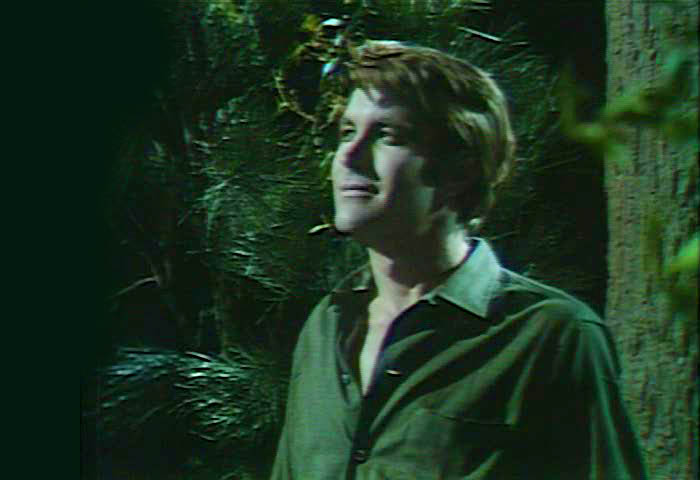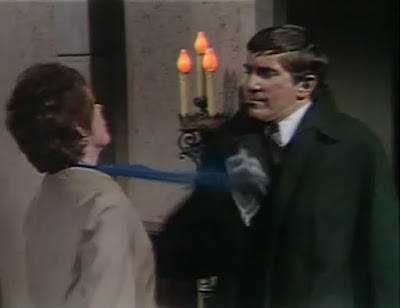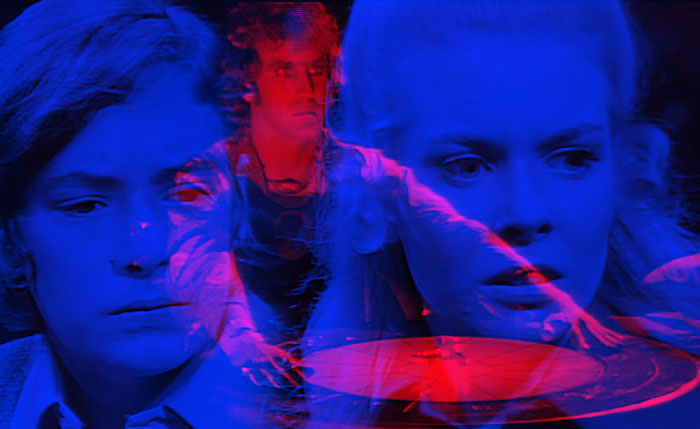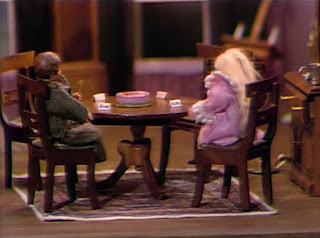
By PATRICK McCRAY
Taped on this date in 1968: Episode 566
Barnabas becomes suspicious of Julia when she begins sleeping all day, wearing high collared shirts, and longing for the embrace of the undead. Tom Jennings: Don Briscoe. (Repeat; 30 min.)
Julia is attacked and bitten by Tom, and later denies it to WIllie, who takes her to Collinwood to recover. She instructs Mrs. Johnson to leave her alone, and when the housekeeper brings her a letter from Barnabas, she tears it up. Later, Julia is summoned by Tom for the second meal of the day, and upon coming back to Collinwood, her bite marks are discovered by Barnabas.
I know that alcoholism isn’t funny. And drunks aren’t funny.
Having made that clear, Dark Shadows was produced before these modern opinions, and we’re swimming in its pool, so get that lampshade off your head and jump in. Once you’ve seen the episodes enough times, which could mean just once, it becomes pretty clear that the writers often had a good time by doing an episode in drag. I don’t mean that Sam Hall was wearing a dress, because I always saw him as more of a smart, designer pantsuit kinda guy, much like future tv hunk, Bea Arthur. No, I simply mean that the episodes are often about something else. Usually with no conclusion. Just an opportunity to explore a situation or human moment that was fun or challenging or necessary to write about. All you have to do is re-frame a little bit of the context.
 I think the reason that drinking was kind of funny for so long was that the drinkers were often in on the joke, and the joke kind of changed before, during, and after the imbibing. “Morning after“ humor is a strange mix of regret, everyone agreeing to ignore the obvious after-effects, and the paradoxical pursuit of hair of the dog. In this case, the dog is Tom Jennings. Because if you look at this episode and kind of ignore the bite marks on its neck, it looks for all the world like Julia is sleeping off a hangover and everyone is either trying to deny what they know or find out what they fear. And it’s not just a minor hangover. This is, in the immortal words of Robert Urich, “a full, adult-size bangaroo.” It’s also perfect commedia dell’arte, where the hapless servants are trying to understand the decadence of one half of the household and then cover it up to the rest. What can Mrs. Johnson possibly be thinking? She worked for Burke Devlin, so whatever it is, it can’t be new.
I think the reason that drinking was kind of funny for so long was that the drinkers were often in on the joke, and the joke kind of changed before, during, and after the imbibing. “Morning after“ humor is a strange mix of regret, everyone agreeing to ignore the obvious after-effects, and the paradoxical pursuit of hair of the dog. In this case, the dog is Tom Jennings. Because if you look at this episode and kind of ignore the bite marks on its neck, it looks for all the world like Julia is sleeping off a hangover and everyone is either trying to deny what they know or find out what they fear. And it’s not just a minor hangover. This is, in the immortal words of Robert Urich, “a full, adult-size bangaroo.” It’s also perfect commedia dell’arte, where the hapless servants are trying to understand the decadence of one half of the household and then cover it up to the rest. What can Mrs. Johnson possibly be thinking? She worked for Burke Devlin, so whatever it is, it can’t be new.
In the midst, Barnabas is more of a fussbudget than ever. He had to put up with months of Nathan Forbes and, I’m sure, more than one night of Jeremiah in his cups, thumping around the almost-Old House while chasing maids or sneaking in doxies from the docks. In the 20th century, that level of wanton sherry consumption might pass at Collinwood, but this is his house, thank you, and Young Loomis and Dr. Hoffman were hand-picked because they didn’t go in for those sorts of shenanigans. Which is why he wants to get to the bottom of it, even more. And Willie does everything to keep him from knowing. And Julia, knowing exactly what Barnabas is up to, tears up Barnabas‘s note, because it probably said, “Lay off the sauce and get back to work, you lug.”
The scene where Willie and Barnabas have their confrontation in the lab is priceless, because someone has forgotten his lines, and I can’t wager which one it was. But Barnabas seems so appalled at what’s happened that awkward silence mixed with helpless astonishment are indistinguishable from a fully-voiced response. If anything, it’s more realistic. I mean, what do you say? This is an episode with no really progressive dialogue, just evasion and implication with Tom Jennings in the middle.
Tom is the bartender here, and he’s worse than the clientele. Actually, that’s stretching it all. Tom Jennings is a very peculiar vampire. Maybe one of the scariest, because he’s the most consistently feral. Via makeup and performance, Don Briscoe emphasizes the undead and driven quality of the monster, stripping away the velveteen refinement and leaving a working-class killer underneath… and perhaps the portrayal is a commentary on class paranoia by the writers. (It’s a reflection, anyway.) Barnabas can be trusted with the satanic powers of the undead; he’s been to university. But a guy like Tom Jennings? Lock up your Doctor Hoffmans! There’s a union man on the loose!
Episodes like 566 are situational popcorn. Even when monotonous, they are character-driven delights to watch. Like any good sitcom, I know exactly what’s coming and yet it always satisfies. Actually, it satisfies on a more metaphysical level even than that. Barnabas had his chance with Julia and he ignored it. Rather than see her victimized, I almost see her avenged, and the vaguely post-coital splay and daze in which she’s found by Willie and Barnabas after her two encounters say far more than what’s on the page. Is Barnabas horrified because she was claimed by a vampire or by a vampire other than he?
Julia is attacked and bitten by Tom, and later denies it to WIllie, who takes her to Collinwood to recover. She instructs Mrs. Johnson to leave her alone, and when the housekeeper brings her a letter from Barnabas, she tears it up. Later, Julia is summoned by Tom for the second meal of the day, and upon coming back to Collinwood, her bite marks are discovered by Barnabas.
I know that alcoholism isn’t funny. And drunks aren’t funny.
Having made that clear, Dark Shadows was produced before these modern opinions, and we’re swimming in its pool, so get that lampshade off your head and jump in. Once you’ve seen the episodes enough times, which could mean just once, it becomes pretty clear that the writers often had a good time by doing an episode in drag. I don’t mean that Sam Hall was wearing a dress, because I always saw him as more of a smart, designer pantsuit kinda guy, much like future tv hunk, Bea Arthur. No, I simply mean that the episodes are often about something else. Usually with no conclusion. Just an opportunity to explore a situation or human moment that was fun or challenging or necessary to write about. All you have to do is re-frame a little bit of the context.
 I think the reason that drinking was kind of funny for so long was that the drinkers were often in on the joke, and the joke kind of changed before, during, and after the imbibing. “Morning after“ humor is a strange mix of regret, everyone agreeing to ignore the obvious after-effects, and the paradoxical pursuit of hair of the dog. In this case, the dog is Tom Jennings. Because if you look at this episode and kind of ignore the bite marks on its neck, it looks for all the world like Julia is sleeping off a hangover and everyone is either trying to deny what they know or find out what they fear. And it’s not just a minor hangover. This is, in the immortal words of Robert Urich, “a full, adult-size bangaroo.” It’s also perfect commedia dell’arte, where the hapless servants are trying to understand the decadence of one half of the household and then cover it up to the rest. What can Mrs. Johnson possibly be thinking? She worked for Burke Devlin, so whatever it is, it can’t be new.
I think the reason that drinking was kind of funny for so long was that the drinkers were often in on the joke, and the joke kind of changed before, during, and after the imbibing. “Morning after“ humor is a strange mix of regret, everyone agreeing to ignore the obvious after-effects, and the paradoxical pursuit of hair of the dog. In this case, the dog is Tom Jennings. Because if you look at this episode and kind of ignore the bite marks on its neck, it looks for all the world like Julia is sleeping off a hangover and everyone is either trying to deny what they know or find out what they fear. And it’s not just a minor hangover. This is, in the immortal words of Robert Urich, “a full, adult-size bangaroo.” It’s also perfect commedia dell’arte, where the hapless servants are trying to understand the decadence of one half of the household and then cover it up to the rest. What can Mrs. Johnson possibly be thinking? She worked for Burke Devlin, so whatever it is, it can’t be new.In the midst, Barnabas is more of a fussbudget than ever. He had to put up with months of Nathan Forbes and, I’m sure, more than one night of Jeremiah in his cups, thumping around the almost-Old House while chasing maids or sneaking in doxies from the docks. In the 20th century, that level of wanton sherry consumption might pass at Collinwood, but this is his house, thank you, and Young Loomis and Dr. Hoffman were hand-picked because they didn’t go in for those sorts of shenanigans. Which is why he wants to get to the bottom of it, even more. And Willie does everything to keep him from knowing. And Julia, knowing exactly what Barnabas is up to, tears up Barnabas‘s note, because it probably said, “Lay off the sauce and get back to work, you lug.”
The scene where Willie and Barnabas have their confrontation in the lab is priceless, because someone has forgotten his lines, and I can’t wager which one it was. But Barnabas seems so appalled at what’s happened that awkward silence mixed with helpless astonishment are indistinguishable from a fully-voiced response. If anything, it’s more realistic. I mean, what do you say? This is an episode with no really progressive dialogue, just evasion and implication with Tom Jennings in the middle.
Tom is the bartender here, and he’s worse than the clientele. Actually, that’s stretching it all. Tom Jennings is a very peculiar vampire. Maybe one of the scariest, because he’s the most consistently feral. Via makeup and performance, Don Briscoe emphasizes the undead and driven quality of the monster, stripping away the velveteen refinement and leaving a working-class killer underneath… and perhaps the portrayal is a commentary on class paranoia by the writers. (It’s a reflection, anyway.) Barnabas can be trusted with the satanic powers of the undead; he’s been to university. But a guy like Tom Jennings? Lock up your Doctor Hoffmans! There’s a union man on the loose!
Episodes like 566 are situational popcorn. Even when monotonous, they are character-driven delights to watch. Like any good sitcom, I know exactly what’s coming and yet it always satisfies. Actually, it satisfies on a more metaphysical level even than that. Barnabas had his chance with Julia and he ignored it. Rather than see her victimized, I almost see her avenged, and the vaguely post-coital splay and daze in which she’s found by Willie and Barnabas after her two encounters say far more than what’s on the page. Is Barnabas horrified because she was claimed by a vampire or by a vampire other than he?
This episode hit the airwaves Aug. 26, 1968.


